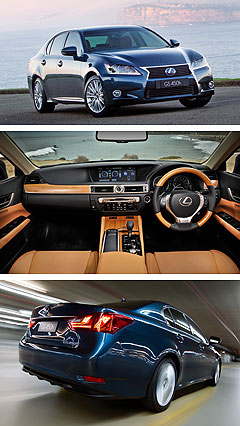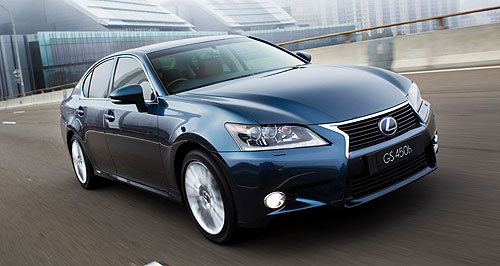Make / Model Search
New models - Lexus - GS - GS450h sedanLexus broadens hybrid GS appealHigh-end hybrid: The new Lexus GS450h will get some competition in the luxury hybrid segment later this year with the arrival of models from Audi, BMW and Infiniti. Wider range, sharper value for thriftier GS450h as Lexus gets set for rush of rivals15 May 2012 THE latest hybrid Lexus GS450h is faster, more frugal and better value than its predecessor that became Australia’s first hybrid luxury car when it was launched in the third-generation Lexus GS range in 2008. Six years on, the all-new GS450h is still the only hybrid in the mid-size luxury class in Australia, but Toyota’s prestige brand will finally get some competition here over the next 12 months from German brands BMW and Audi and Japanese rival Infiniti. Lexus has broadened the appeal of the hybrid GS by widening the petrol-electric range from one model to three, while dropping the price of entry by a handsome $26,814, to $99,900 (plus on-road costs). With the V8-powered GS460 having been dropped, the GS450h effectively becomes the flagship of the range, priced above the six-cylinder petrol models, perhaps until a rumoured GS F arrives on the scene. Consuming just 6.3 litres of petrol per 100km on the official combined test, the new Lexus GS450h is some 20 per cent more efficient than the earlier version and 3.0L/100km superior to the next most efficient GS model in the new range, the entry level GS250 (9.3L/100km). Carbon dioxide emissions have been cut from 186 grams per kilometre to a diesel-beating and class-best 145g/km – an improvement of 11 per cent. This is partly due to a more slippery profile that delivers a drag coefficient of 0.26Cd, matching the Mercedes-Benz E-Class to be one of the world’s most aerodynamic passenger sedans. As well, Lexus engineers have ramped up the GS450h’s regenerative braking system to capture more energy from each brake application. The parallel hybrid powertrain has a similar layout to before, but the powertrain is said to be completely new.  Left: Lexus GS450h. Left: Lexus GS450h.The 215kW/352Nm 3.5-litre V6 petrol engine now employs a more efficient Atkinson cycle system, as used on other Toyota hybrids such as the four-cylinder Prius and Camry Hybrid. This design delays the intake valve closing for reduced compression volume but a higher compression ratio of 13:1. In a world first for Lexus, the GS450h’s V6 becomes the first Atkinson cycle engine to get both direct and port injection – a system previously used only on high-performance engines to deliver both high power and low emissions. As well, Lexus has trimmed the engine’s weight and reduced friction to enhance efficiency. As before, the petrol engine runs in concert with two electric motors – one that acts primarily as an electricity generator and the other as the main drive motor. The 147kW/275Nm electric drive motor powers the rear wheels via a new and more efficient planetary-gear continuously variable transmission (CVT), this time with paddle-shift levers. Although the combined petrol-electric power and torque figures are no higher than before, Lexus has snipped 0.3 seconds from the 0-100km/h sprint time, to 5.9 seconds – a split second slower than the petrol-only GS350 that was launched locally in early April. The GS450h’s looming rival, the BMW 5 Series ActivHybrid, stops the clocks at the same 5.9 seconds, while the German car’s fuel economy figure is line-ball at 6.4L/100km, according to early figures published in Europe. The hybrid Audi A6, with its smaller four-cylinder petrol engine, is slower at 7.3 seconds, but marginally more efficient at 6.2L/100km. Fastest of the lot should be Infiniti’s M35h that is due in Australia in the third quarter of this year. It is regarded as the world’s fastest hybrid production car with a 0-100km/h time of 5.5 seconds, but is thirstier, with a fuel economy figure of 7.0L/100km. For the first time, the Lexus GS hybrid has a choice of five drive modes – EV, Eco, Normal, Sport and Sport+ – that adjust electric power steering aggressiveness, powertrain response, comfort settings and chassis control. EV mode provides 2km of petrol-free motoring up to 50km/h, provided the battery has sufficient charge. In Eco mode, power is limited to 500 volts to conserve electricity, while pressing the Sport button boosts power to 650 volts for higher performance. Despite the proliferation of lithium-ion batteries in electrified vehicles – including Toyota’s upcoming Prius V people-mover – the GS450h retains the older-style nickel-metal hydride storage cells, as used in the Toyota Prius hatch, to keep cost down. The 240 battery cells are now stacked between the rear suspension towers to liberate an extra 45 per cent of boot space, up to 464 litres. As well, a DC converter has been included to provide ancillary power, and is part of the power control unit, which itself has been upgraded with water cooling and a lift in amperage from 120 to 150. This system now also does away with the alternator, increasing engine efficiency. The new GS450h now comes in the same three equipment levels as the GS250 and GS350 – Luxury, F Sport and Sport Luxury. Hybrid pricing now starts at $99,900 for the Luxury variant – a whopping $26,814 less than the previous lone Super Luxury model that sold for $126,714. In fact, all three GS450h models can be had for less than the outgoing hybrid model, with the mid-range F Sport sliding in at $111,900 and the Sport Luxury at $121,900. The Luxury variant opens with adaptive variable suspension, blind-spot monitor, selectable driving modes, tyre-pressure monitor, DAB+ digital radio, 15-way electric adjustable driver’s seat, sat-nav and head-up display. The harder-edged F Sport becomes the first hybrid car in the world to feature rear-wheel steering as part of its standard sports handling package. This electronically controlled rear-steer system operates in Sport+ mode, pointing the rear wheels in the opposite direction to the front wheels to aid maneuverability at up to 80km/h, and then in the same direction as the front wheels above that speed for high-speed stability. As well, the F Sport adds sports suspension settings, bigger 19-inch alloys, dynamic handling system, body kit, sports interior with 18-way driver’s bucket seat, variable-ratio steering, bigger two-piece front disc rotors with four-piston calipers, a pre-collision system, active cruise-control and integrated vehicle dynamics. The flagship Sports Luxury gains a mega 12.3-inch LCD screen – said to be the world’s biggest – along with a driver fatigue monitor, a more advanced pre-collision system, 20-way adjustable front seats, premium Mark Levinson sound system with 17 speakers, tri-zone climate-control with rear-seat controls, auto high beam, wood-grain trim and window sunshades. To save power, the GS450h Sport Luxury gets Lexus’s S-Flow climate-control air-conditioning that switches off vents to unoccupied seats to save power. This system can also direct fresh air to the windscreen for demisting while recirculating air into the footwells. GS45h Luxury buyers can lay down $4500 for a safety package that incorporates the pre-crash system and active cruise control. F Sport buyers can upgrade with a $5000 pack of Sport Luxury items, including LED headlights, Levinson audio and 12.3-inch display.
 Read more4th of April 2012  Lexus 2012 GS Sedan rangeNew from the ground up, the fourth-generation luxury Lexus GS gets serious3rd of April 2012  First drive: GS marks Lexus rebirthAll-new Lexus GS luxury mid-sizer gets serious against BMW, Benz and AudiAll new models Alfa Romeo Alfa Romeo Abarth Abarth Audi Audi Aston Martin Aston Martin BMW BMW Bentley Bentley Chrysler Chrysler Chevrolet Chevrolet Dodge Dodge Citroen Citroen Ferrari Ferrari DS DS Ford Ford Fiat Fiat FPV FPV Foton Foton Haval Haval Great Wall Great Wall Honda Honda Holden Holden Hyundai Hyundai HSV HSV Isuzu Isuzu Infiniti Infiniti Jaguar Jaguar Iveco Iveco Kia Kia Jeep Jeep Land Rover Land Rover Lamborghini Lamborghini Maserati Maserati Lexus Lexus McLaren McLaren Mazda Mazda Mercedes-Benz Mercedes-Benz Mitsubishi Mitsubishi Mini Mini Opel Opel Nissan Nissan Porsche Porsche Peugeot Peugeot Ram Ram Proton Proton Rolls-Royce Rolls-Royce Renault Renault Skoda Skoda Saab Saab SsangYong SsangYong Smart Smart Suzuki Suzuki Subaru Subaru Toyota Toyota Tesla Tesla Volvo VolvoGS pricing
Motor industry news |
|
||||||||||||||||||||











Facebook Twitter Instagram